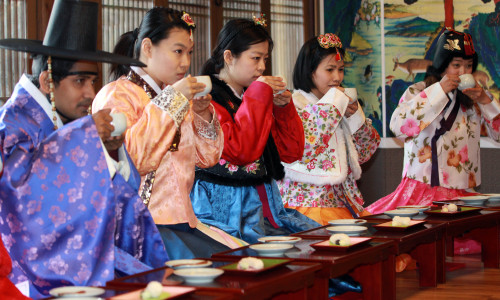The number of new Korean family names and clans seems to be rising in South Korea, with growing numbers of marriage immigrants choosing to create their own names to adapt to the local community.
South Korea, according to a census conducted in late 2000, had 286 family names divided into 4,179 clans, with Kim, Lee and Park among the most popular Korean surnames.
With a growing influx of foreigners to South Korea over the last decade, more foreigners are crafting their own Korean family names or taking popular Korean surnames under their original clans, court documents showed Thursday.

In South Korea, having the same last name does not always mean people are related. For over 1,000 years, Koreans have maintained a unique system of using the name of their hometown as an important way to differentiate their identities. For example, there are 285 regional origins for Kims, such as the “Gyeongju Kim” clan and the “Gimhae Kim” clan.
The number of naturalized foreigners who register their own last names under new clans has steadily increased, rising to 7,038 last year, up from 3,193 in 2008 and 5,893 in 2009, according to the Supreme Court, which oversees family name registrations.
Most of them, however, took existing Korean surnames with a new clan based on their origins, giving some historical background of where they came from. For example, two recently registered clan names in the nation’s census data were “Mongol Kim” and “Taeguk Tae,” the latter derived from the first syllable of the Korean word for Thailand.
The most widely used last name, Kim, makes up 22 percent, which is equivalent to almost 10 million people, while those surnamed Lee account for 14 percent.
The hike is in tandem with the steady and growing influx of foreign spouses from Southeast Asian nations through international marriages and new immigration laws allowing Chinese nationals of Korean background to acquire Korean citizenship.
The number of foreigners naturalized as Koreans surpassed the landmark 100,000 last month, 63 years after the establishment of the South Korean government in 1948.
Although there are foreigners who apply for their own family names soon after getting citizenship here, a considerable number of them created new names as their children prepared to enroll in Korean schools, officials said, indicating persisting prejudice against children from multicultural families.
“In the case of women who came here to marry Korean men, they do not care much about making their own family name as their children follow their father’s surname under his clan,” a court official said. (Yonhap News)
<한글 기사>
태국 태.몽골 김씨..다문화사회 이색 姓本 속출
태국 태씨, 몽골 김씨, 청원 우씨, 진천 조씨 등 이전에는 없었던 '새로운 가문'이 속속 생겨나고 있다.
이는 귀화를 통해 대한민국 국적을 취득한 결혼이주여성 등 국내에 거주하는 외 국인들이 늘어나면서 생긴 현상이다.
법무부 통계로 볼 때 결혼이민자는 2001년 2만5천182명에 불과했으나 매년 1만 명가량 늘어 지난해 14만1천654명으로 급증했다는 점에서 귀화 후 새로운 성씨와 본 관을 만드는 '창성창본(創姓創本)' 역시 더욱 많아질 것으로 보인다.
결혼이민자를 성별로 나누면 여성이 12만3천93명으로 압도적으로 많다.
◇"자녀 취학하는데 제 이름도 바꿔야죠" = 10일 대법원에 따르면 귀화 후 성씨 와 본관을 만드는 귀화 외국인은 2008년 3천193명에서 2009년 5천893명, 지난해 7천 38명에 달하는 등 꾸준한 증가세를 보이고 있다.
법원별로 보면 지난해 기준 서울이 1천766명으로 가장 많았고 수원(1천281명), 인천(627명), 대구(502명), 광주(492명), 대전(466명), 창원(419명), 의정부(344명) , 전주(303명), 부산(271명), 청주(217명) 등의 순이었다.
그러나 귀화 외국인은 2008년 1만1천518명, 2009년 2만5천44명, 지난해 1만6천3 13명에 달했다는 점에서 외국인들이 국적 취득 후 바로 성씨와 본관을 만드는 것은 아닌 셈이다.
창성창본과 귀화 외국인 수의 차이는 밝지만은 않은 다문화가정의 어두운 한 단 면을 보여주고 있다.
법원 관계자는 "귀화 후 새로운 성씨와 본관, 이름을 만드는 '창성창본'을 바로 신청하는 경우도 있지만 원래 이름을 갖고 생활하다가 자녀 취학을 앞두고 다문화가 정이라는 것이 서류상 드러나지 않도록 성씨와 이름을 만드는 경우도 많다"고 귀띔 했다.
즉, 귀화 후 이름을 뒤늦게 바꾸는 현상은 어머니의 이름에서 눈치챌 수 있는 다문화가정 자녀에 대한 '차별'이라는 그림자가 여전히 존재하고 있음을 간접적으로 나마 보여준다는 지적이다.
◇"우린 작명소 안 가요" = 상당수의 개명 신청자들이 이름을 바꾸는 이유는 "이름이 좋지 않아 나쁜 일이 생긴다"는 것이 대다수다.
범죄 의도가 없다면 무리 없이 허가되지만 결혼이주여성들이 성씨와 본관을 만들면서 짓는 이름은 '성명철학'과 거리가 멀다.
물론 김, 이, 박, 최 등 우리나라의 주요 성씨를 선호하기는 하지만 자신의 원래 이름 중 일부분으로 성씨와 이름을 짓는가 하면 발음이나 표기상 비슷한 이름을 짓는 경우도 많다.
중국에서 살다가 우리나라 청년과 결혼한 한 여성(34)은 자신의 원래 성씨인 우 씨를 그대로 쓰면서 본관은 거주지인 '청원(충북)'으로 골랐고 이름 역시 한자를 한국식 발음으로만 고쳐 등록했다.
별다른 게 없는 것처럼 보이지만 '청원 우씨'라는 새로운 성씨가 생긴 것이다.
동구에서 온 30대 여성도 자신의 이름 첫 글자인 '팍'자와 비슷한 '박'을 성씨로 선택했으며 본관은 우리나라에서 흔히 볼 수 있는 '밀양(경남)'으로, 이름 역시 자신의 원래 이름에서 3글자를 땄다.
이름이 마치 세례명처럼 들려 주변에서 "성당에 다니느냐"는 말을 많이 듣는다 고 한다.
또 다른 여성(31)은 자신의 원래 이름에 포함된 '아미'의 사전상 의미가 '미인 의 눈썹'을 뜻한다는 점에 착안해 성씨와 본관만 고른 뒤 이름은 아미를 그대로 썼다.
이런 탓인지 우리나라에서는 찾아보기 힘들던 한양 김씨가 많아졌는가 하면 몽골 김씨, 산동 우씨, 대마도 윤씨 등 새로운 가문도 생겨났다.
법원 관계자는 "결혼이주여성들은 출산한 자녀가 아버지의 성씨와 본관을 따른 다는 점에서 자신의 창성창본은 크게 신경을 쓰지 않는 것 같다"고 말했다.
(연합뉴스)








![[Kim Seong-kon] Democracy and the future of South Korea](http://res.heraldm.com/phpwas/restmb_idxmake.php?idx=644&simg=/content/image/2024/04/16/20240416050802_0.jpg&u=)







![[KH Explains] Hyundai's full hybrid edge to pay off amid slow transition to pure EVs](http://res.heraldm.com/phpwas/restmb_idxmake.php?idx=652&simg=/content/image/2024/04/18/20240418050645_0.jpg&u=20240418181020)

![[Today’s K-pop] Zico drops snippet of collaboration with Jennie](http://res.heraldm.com/phpwas/restmb_idxmake.php?idx=642&simg=/content/image/2024/04/18/20240418050702_0.jpg&u=)